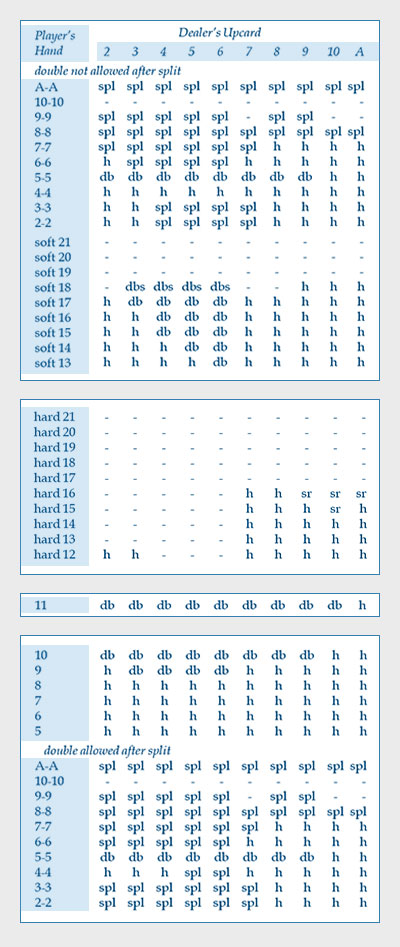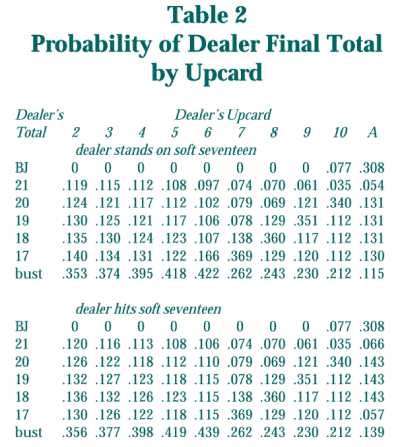Generic Basic Strategy
PostedThe following is an excerpt from Professional Blackjack by Stanford Wong – Published 1994
Basic strategy is the best way to play a blackjack hand on the first round after a shuffle, assuming you see no cards other than your own and the dealer’s upcard. For a person who does not count cards, basic strategy is the best way to play every hand.
This chapter presents basic strategy for single exposure, which is blackjack where the dealer has one card face up for you to see as you are playing your hand. Basic strategy is what plays you should make if you are not counting cards and you do not have any information about the dealer’s hole card. It is presumed that you know the total in your own hand and the dealer’s upcard, but no other cards. Chapter 19 contains basic strategy for double exposure, which is blackjack where the dealer has two cards face up.
Calculating Basic Strategy
Basic strategy can be either total-dependent or composition-dependent. Total-dependent means the strategy numbers require only the dealer’s card and the total points in your hand. Composition-dependent means the strategy numbers require knowledge of the dealer’s card and the precise cards that make up your hand.
For example, total-dependent strategy says stand on twelve against 4. Composition-dependent strategy for twelve against 4 requires you to specify how you get to twelve: Do you have 7-5, 8-4, 3-2-2-5, or what? If you get to twelve by 10-2 or 2-10 (where 10 means any 10-count card), and two or fewer decks are being used (or seven or fewer if the dealer stands on soft seventeen), you should hit. If you get to twelve by any other route, or enough decks are being used, you should stand.
See Peter Griffin’s The Theory of Blackjack for a good discussion of composition-dependent strategy. (The 10-2 versus 4 advice is from page 176 of Griffin’s book.) There are few differences between composition dependent and total-dependent strategies for single deck, and none that are important for multiple decks. (The more decks shuffled together, the less difference one card makes.) This book uses total-dependent strategy.
The details of basic strategy depend on the particulars of the rules. However, you must start someplace. This chapter presents a version of basic strategy that is approximately correct for the most common sets of rules — a generic basic strategy.
Blackjack is most commonly played with the dealer’s hand showing one card face up. If you are playing blackjack in a game where you get to see two cards face up in front of the dealer before you play your hand, go to chapter 19 for playing-strategy advice.
Table 1 presents generic basic strategy. It contains advice for every decision the blackjack player commonly makes. Each column is a different dealer upcard. (10, J, Q, and K are lumped together as 10.) Each row is a different player hand. Technically, table 1 is basic strategy for multiple decks and dealer stands on soft seventeen. Pairs The order of decisions presented in table 1 is the order in which you evaluate your hand.
Table 1
Generic Basic Strategy

KEY
- – : Stand
- db: Double down; if you cannot double, then hit.
- dbs: Double down; if you cannot double, then stand.
- h: Hit.
- spl: Split.
- sr: surrender; if you cannot surrender, then hit.
Do you have a pair?
At most casinos, any two 10count cards, e.g. J-K, are a pair and may be split. If you have a pair, the first part of table 1 tells you how to play your hand. Use this first part of the table to decide whether to split your pair. To split means to make another bet equal in size to your first bet, and play each card as the start of a separate hand. If you split a pair and catch another card of the same value, resplit if you can.
If it is correct to split a pair, it is correct to resplit. You may or may not be allowed to double down after splitting a pair. For example, if you split 8-8 and catch a 3 for eleven, you may or may not be allowed to double down on that eleven. If doubling down after splitting is allowed, then splitting is more attractive and you should split more often.
The first part of table 1
Soft Hands
Do you have an ace? Aces count your choice of either eleven or one. A hand in which an ace counts eleven is called a soft hand, and the total points in it are called a soft total. The second part of table 1 explains how to play soft hands.
The double-down advice is broken down into db and dbs. The reason is you need to know what to do with a particular total if you cannot double down. For example, suppose you have soft eighteen and the dealer shows 3.
Your best play is to double down, so that is what you do if you can. But if your soft eighteen is a three-card hand, say ace-2-5, then you probably will not be allowed to double down. Table 1 lists “dbs” for that hand, which means if you are not allowed to double down then you should stand.
Note that sometimes it is correct to hit eighteen. If you have soft eighteen and the dealer shows 9, 10, or ace, then hitting your soft eighteen is better than standing on it. One decision that is very close is soft thirteen against 5. It does not matter whether you hit or double down.
Hard Hands
The lower two parts of table 1 explain how to play the rest of your hands. Hands labeled “hard” might contain aces, but under the circumstances all such aces are counted as one. Hands tabulated as from 5 to 11 do not contain an ace; if a hand totaling eleven or less has an ace it is a soft hand and is played according to the “soft” part of the table.
Surrender
Surrender means losing half a bet for the privilege of not playing out the hand. Late surrender means you cannot surrender if the dealer has a natural. The table of generic basic strategy includes strategy for late surrender.
Most of the value of late surrender comes from surrendering sixteen against 10. Late surrender is worth 0.1% to a basic-strategy player. If you are playing blackjack at a casino that does not offer surrender, or if you are not allowed to surrender due to having more than two cards, then hit those hands for which table 1 advises surrender. Insurance Table 1 does not show insurance.
Basic strategy says never take insurance. Even if you have a natural, you are better off not insuring it. You are better off winning 3:2 most of the time than winning even money for sure. Dealer Final Totals Table 2 is an aid in understanding the strategies presented in this book.
It gives the probability of various dealer final totals for a given dealer upcard. For example, a dealer starting with a 7 has a .369 probability of ending up with exactly seventeen. The total for each column sums to 1.000 except for rounding.
The top half of table 2 applies when the dealer stands on soft seventeen, and the lower half is for the dealer hits soft seventeen. The numbers in table 2 have been found by simulations with six decks shuffled, five dealt out. Other numbers of decks would yield slightly different results.

Source:
Excerpt from Professional Black, Author Stanford Wong – https://bj21.com/books/professional-blackjack-by-stanford-wong